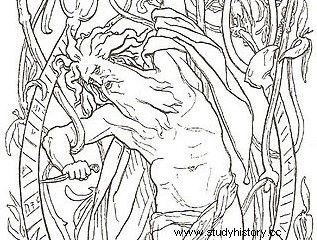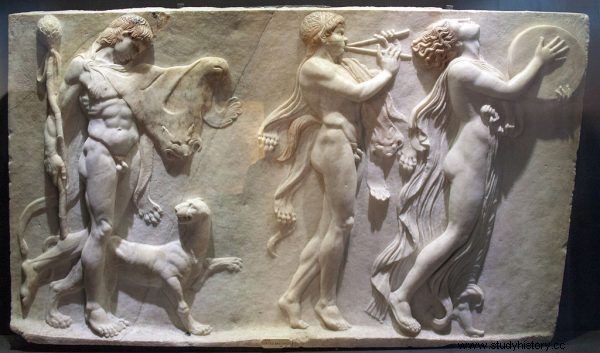Although the theme of death and resurrection is commonly associated with Easter and the figure of Jesus Christ, it was present in many other cultures. Here are 3 famous deities who also reborn after death.
In ancient times, the presence of the dying and rebirth god of nature in mythology was quite common. In this way, people explained to themselves the cycle of changes taking place in nature, and expressed their hopes that life does not end with the death of the body. So let's take a look at some of them.
The Egyptian Model of Immortality
Osiris is the deity of the solar circle in the Egyptian pantheon. He was one of the four children of Geb and Nut (Earth and Heaven). Its form was strongly related to the vegetation of plants - just like a grain deposited in the ground does not perish, but vegetates to produce crops; yes Osiris, despite his death, comes back to life . God was also associated with the phases of the moon because of its cyclicality in symbolic decay and rebirth. This makes him very similar to the Greek character of Dionysus.

One of the gods who returned from the dead was Odin
The Osiris myth tells of a conflict with his brother Set, who was plotting against him. Set, having secretly measured his brother's body, prepared a beautiful box, which he then presented at one of the feasts. God promised the chest to whoever would fit it, and thus, when Osiris lay down, the conspirators immediately slammed the lid shut and sealed it. The chest with the god was then thrown into the river.

Osiris was brought back to life by Isis
The desperate wife of Osiris - Isis, went in search of the body of her beloved. She found him only years later at the royal court in Byblos. She took her deceased husband's body home and brought him back to life. When Set found out about these events, he searched for the body of Osiris again, and this time he cut it into 14 pieces and then scattered it along the Nile.
Isis again sought out all the parts, and on the site where they were found, she established the Osiris cult. The goddess and her sister Nephthys revived the body of a god enough for Isis to become pregnant. Born of this union, Horus then declared battle against Set. Osiris, however, no longer took part in further events on earth. From then on, he ruled in the Land of the Dead.
A very interesting aspect of the figure of Osiris is also his activity as king during his reign on earth. According to the myth, it was supposed to change the lives of the Egyptians, depriving them of primitive and brutal habits. Then he civilized the whole world. He did this during journeys where he converted people with his words, songs and poetry.
Double birth
Greek Dionysus or later Roman Bakhus is a special deity. He is commonly known as the god of wine and vegetation, but that's just one aspect he patronized. In addition to blissful intoxication, Dionysus could also send madness, lust for blood. He was the confidant and companion of the dead souls, and the protector of the persecuted and suffering.

Hera condemned Dionysus to madness and eternal wandering around the world
Dionysus was the son of Zeus and Semele, who died before giving birth in a fire caused by a lightning strike sent by Zeus. However, the child was saved. Zeus took Dionysus from his mother's belly and wrapped it in ivy, then hid it in his own body for the fetus to mature and be born again.
As we can guess, the birth of Dionysus meant another betrayal of Zeus in relation to his wife Hera, so she did not feel love for the newborn child. In her youth, she sent the Titans upon him, who seized him, tore him to pieces, and then boiled him in a cauldron. However, he was brought back to life by his grandmother Rea and then turned into a ram by his father to hide him from Hera's fury. However, the divine wife saw the trick, sent madness on him and condemned him to wandering around the world forever.
One-eyed god of wisdom
Odin was the highest and oldest Norse god of the Viking Age, the creator of all things, ruling the world and the course of all events. One day, driven by a hunger for knowledge, he set off on a journey to the underworld to stand before the deepest root of the Yggdrasill Tree that holds the world. This tree contained all the wisdom that a god wanted to possess. After a while, a voice told him that Odin would have to sacrifice himself to gain the knowledge he wanted.
The obedient god prayed to himself for strength and perseverance, and then hung himself from a loop hanging from a branch. His body died, but his soul circled and waited for the right moment to return to its original abode. After nine days, the first opportunity for this came, but Odin regained consciousness, knew that he was only halfway to recognition. So he grabbed the spear leaned on the limb and pierced his own side. This time, however, he died in a different way because the soul did not leave his body.

Odin sacrificing his life
Thus, aware that he was dead, Odin continued to hang staring at the ground until he reached the hidden Source of Wisdom through his soul's eyes. It was guarded by the giant Mimir, who demanded payment for access to the knowledge well. Odin gave him the gold necklaces, the Herföd ring, but besides them the giant demanded his eye.
Odin drank from the spring and possessed the knowledge he desired, then rose from the dead and descended from the tree more powerful than ever before.
The longing for immortality, or life after life, was present in all cultures of the world. The theme of death and rebirth is present in the beliefs and customs of various nations and cultures to this day. The dying and reborn god could bring redemption, knowledge, or restore the order of the rhythm of nature, and most importantly, give hope, for life after death, as well as prosperity in everyday life on earth.
Literature:
- M. Dixon-Kennedy, Encyclopedioa of Greco-Roman Mythology, Oxford 1998.
- M. Jordan, Dictionary of Gods and Goddesse, New York 2004.
- J. Lipińska, M. Marciniak, The Mythology of Ancient Egypt, Warsaw 2002.
- W. Otto, Dionysus. Kult i myth, Warsaw 2017.
- L. Słupecki, Scandinavian Mythology in the Viking Age, Kraków 2011.
- A. Szrejter, Germanic Mythology. Stories about the gods of the frosty North, Gdańsk 2011.
